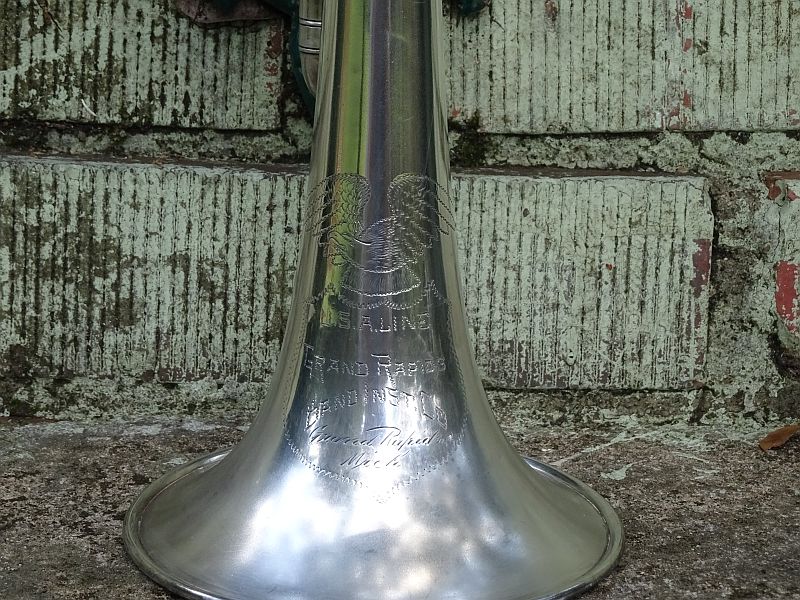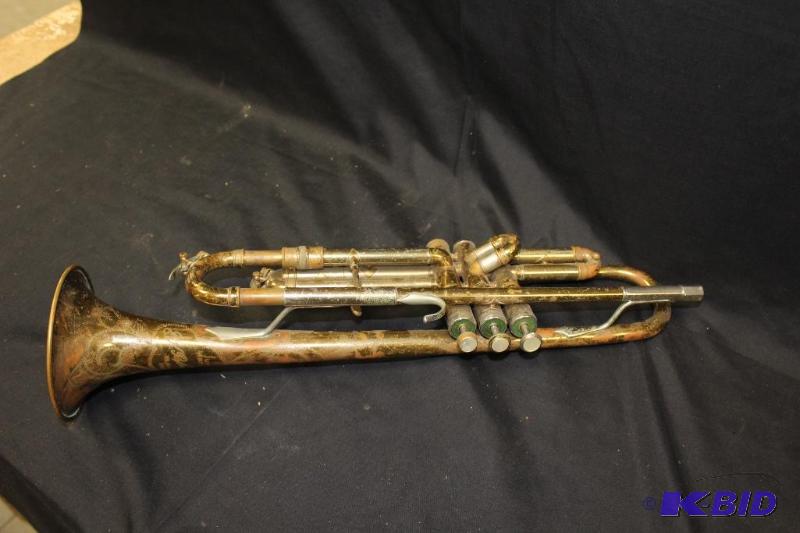Years and Serial Numbers are Approximate.
Buescher Trumpet Serial numbers are most often found on the 2nd valve casing - OR if that is buffed off, check on one of the valves themselves! Pull out a valve and look on the section just below the button and stem. In MOST Buecher trumpets in the 1950s and earlier, you can find the serial number here as well.
Please see the Bell Logos section to see samples of each Bell Logo.
This is a beginning, a starter list, of serial numbers we are accumulating. We have previously guessed at the dates as the only verified purchase dates we have are P. Zimmerman's serial 1425 in 1948 and N. Eldredge's Citation serial 2549 purchased April 13, 1959.
/183/1169183.jpg)
If your Buescher Trumpet/Cornet bares an engraving of an ELK on the bell, please see the note below the serial number chart.

| Serial Number | Year Manufactured | Logo Type |
|---|---|---|
Model Introduced: 'True Tone' 1890-1932 | ||
| 1 | 1888-1904 | |
1903 Fire in Elkhart plant destroys all prior records | ||
| 5000 | 1905 | |
| 5620 | 1906 | |
| 6610 | 1907 | |
| 7808 | 1908 | |
| 8580 | 1909 | |
| 11250 | 1910 | |
| 13685 | 1911 | |
| 15870 | 1912 | |
| 18178 | 1913 | |
| 22860 | 1914 | |
| 25103 | 1915 | |
| 28875 | 1916 | |
| 32350 | 1917 | |
| 37540 | 1918 | |
| 46975 | 1919 | |
| 61255 | 1920 | |
| 78525 | 1921 | |
| 99275 | 1922 | |
| 125750 | 1923 | |
| 150250 | 1924 | |
| 175275 | 1925 | |
| 202350 | 1926 | |
| 222175 | 1927 | |
| 235250 | 1928 | |
| 245250 | 1929 | |
| 255275 | 1930 | |
| 260125 | 1931 | |
Model Introduced: 'Aristocrat' 1932-1963 | ||
| 264025 | 1932 | |
| 265523 | 1933 | |
| 267356 | 1934 | |
| 268971 | 1935 | |
| 272896 | 1936 | |
| 279300 | 1937 | |
| 284418 | 1938 | |
| 288024 | 1939 | |
| 291336 | 1940 | |
Model Introduced: 'The 400' 1937-1966 (?)- Serial Range 283xxx - 438xxx | ||
| 294125 | 1941 | |
| 297527 | 1942 | |
| 303000 | 1945 | |
| 312000 | 1948 | |
| 316000 | 1949 | |
| 326000/332000* | 1950 | |
| 337000 | 1951 | |
| 347000 | 1952 | |
| 350000 | 1955 | |
| 360000 | 1960 | |
| 381000 | 1963 | |
About this time Selmer Purchased Buescher | ||
| 408000 | 1965 | |
| 520000 | 1970 | |
| 630000 | 1975 | |
| 785000 | 1980 | |
| 875000 | 1983 | |
| - | - | |
- Serial numbers - E.K. Blessing All years other than 1906, 1946, 1950, 1955, 1960, 1965, 1970, 1975, and 1980 are approximations. From 1983 onwards, you may calculate the date of manufacture by adding 50 to the two digit prefix of the serial number.
- James Bovinette, professor of trumpet at Iowa State University, enjoys play testing this Blessing Super Artist Vintage Professional Trumpet designed by t.
*1950 Serial number is different on various sites.. so I have listed BOTH numbers, I think the number MORE accurate would be 326000.
Please note that there are a FEW exceptions to this chart.
1) Some of the modern Buescher labeled trumpets from the 1970-present that have serial numbers that do not correspond to this chart. Most seem to have the 'Upsidedown Nike' Bell Logo and are model BU-7. Selmer must have done a serial number 'reset' at some point.
2) I have also noticed some of the 1960s 'Side Scroller' and possibly 'Top Scroller' logoed trumpets/cornets that have serial numbers in the 100,000 range. These obviously are NOT subject to this serial number chart. These are most likely mid to late 1960s instruments.
3) Most (if not all) Buescher trumpets that have the 'ELK' logo have a separate serial number listing. The Valve Block on these instruments are made by Elkhart and thus have a completely different numbering system.
Any Trumpet or Cornet with the engraving of an ELK (see below) will NOT match up on the Buescher Serial number list. They also bear the inscription 'BUILT BY BUESCHER'. These instruments had their OWN serial numbering system. Most were made post World War II possibly up to 1960. If you see one of these horns and the owner is claiming they are from the 1920s or 1930s or before, then they are using the wrong serial number chart. I do not know if an Elkhart Serial number list exists or not.
Big Thanks to Dr Rick's Vinllage Flute and Sax Shop website for providing some of the serial numbers and years produced.
I also gathered information for this page from MusicTrader.com website that cites Albert Mensinga as the source for MANY of the serial numbers.
If you happen to have any additional information that would make this chart MORE accurate, please feel free to email me.
DISCLAIMER: The contents of this web site are for informational purposes only. This web site and its operator are not in the business of buying, selling or advertising musical instruments. The use of the information contained on this web site for purposes of buying, selling or advertising of musical instruments is at the risk of the buyer, seller or advertiser. The operator of this web site does not accept any responsibility for such use or any consequences thereof. Although an attempt is made to provide accurate information, no guarantee is given that the information on this web site is either correct or complete. Information contained on this website may reflect the opinion of the operator of this website.
Ida Marie Grassi Saxophone. Serial number is in the 9000 range. Pads are old and hard. There are numerous small leaks, which result in warbles around the 'G' key. IDA MARIA GRASSI MADE IN ITALY is a trademark and brand of IDA MARIA GRASSI. Gala Washing Machine Manual. The USPTO has given the IDA MARIA GRASSI MADE IN ITALY trademark. Serial Number.

Sequentially, the next model I came across was in the 9000 range: you will now notice that the bell to brace “ring” has replaced the “L” shaped one, the left hand keys remain the same as the model above: Around the 22000 serial, the bell keys on baritones move from left to the right hand side of the bell. Standard MK III and “Jade Rollers” Up to this serial all models are Standard (or no name, just a serial number engraved) models. There are some minor aesthetic changes, such as the Jade coloured low C/Eb and low B/C#/Bb little finger key rollers (see photo below). Download Roms Snes9xtyl Psp. Apparently even the pads on these models were in green coloured leather! Master Key Ebook Free Download. Above you can see a beautiful example with rectangular key touches, so far I have only come across two such “custom” models (one in England and one in Italy). [Correction: after finding yet another of these custom keywork saxes on the web, I can only conclude that the rectangular key touches were offered also on the Standard model.] So an altogether more refined instrument exuding a more “professional” feel, not only in the slickness of the keywork but also in the rich gold lacquer finish. I believe the “Wonderful” was only produced in alto and tenor.
Blessing Super Artist Trumpet Serial Numbers Online
Stangely, after producing the “Wonderful”, I.M. Grassi will continue to make the Standard model (as well as the Concertino, Professional and Prestige) with none of the technical improvements of the “Wonderful” until the mid 80s. We will never know why Grassi decided to end the “Wonderful Model” production, maybe it was due to manufacturing costs or maybe the model wasn’t well received.
Blessing Flugelhorn Serial Numbers
Concertino, Professional and Prestige Approximately to serial number 50000, we can find the following models being produced: Standard, “Concertino”, “Professional” and “Prestige” (these last three model names are actually engraved on the sax, below the serial number). The “Concertino” model was the student model, with bell keys on the left hand side and probably no front F key (unfortunately I have yet to find photos of this model). The “Professional” and “Prestige” look to me to have the same keywork as the Standard models. The majority of the models above are finished in clear gold lacquer and nickel plated keywork. Grassi also made an “Export” model (the name Export does not appear engraved on the body) which was entirely silver plated. “Export” model alto (34000) in silver plate. Model 2000 After the models mentioned above, Grassi will produce the “Model 2000” (NOT to be confused with the “Professional 2000”!).


This is somewhat a transitional model, with most of the characteriscs of the older models but with some updated aesthetic touches, such as the wider more comfortable little finger key touches (the low C/Eb keys are now elongated Selmer SA80 style and no longer round). Leader, Professional 2000 and Prestige Around the mid 80s, Ida Maria Grassi revamps the whole production and at last focuses production on three models: “Leader”, “Professional 2000” and “Prestige” (also known as “Prestige 80”) This last production seems to be the most consistent and finally provides a definitive range of instruments: from student “Leader” to Intermediate “Professional 2000” to professional “Prestige”. [My personal take on this is that the “Professional 2000” was aimed more at the Jazz/Pop market, whereas the “Prestige” was aimed at the Classical market, so rather than two instruments differing in quality, I would say they provided a choice of sound. Of course, the “Prestige” was the most expensive model.] Details of features are as follows: Leader (alto and tenor): • Range to top F (F# optional), • Clear lacquer and nickel plated keys.
